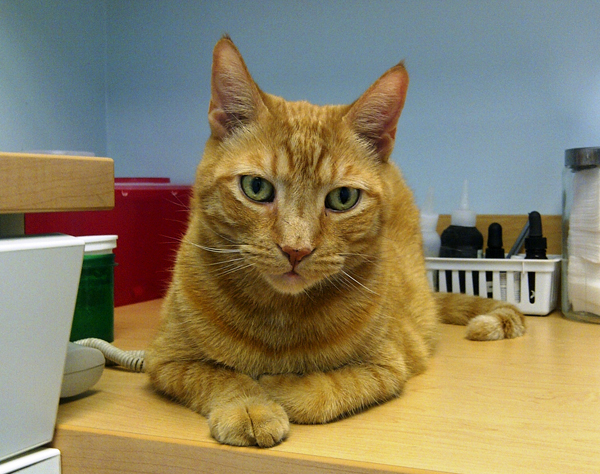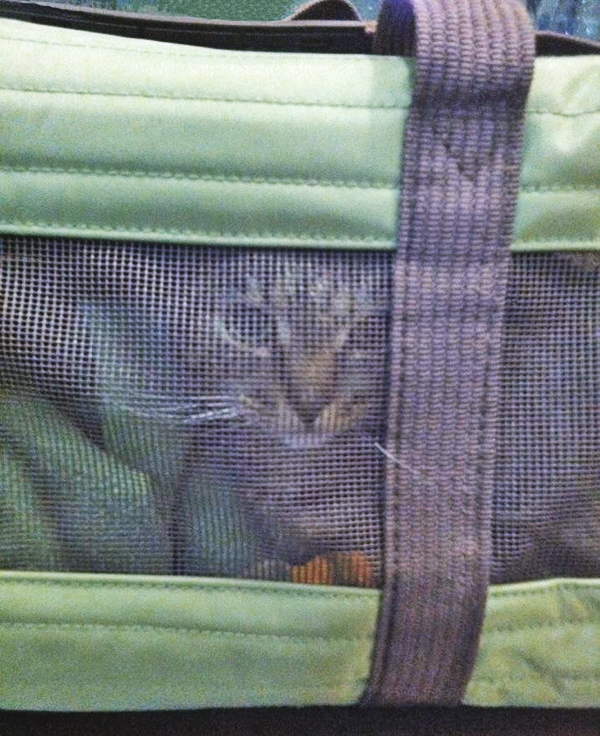You might miss your annual exam and think it’s no big deal. But did you know that pets age much faster than we do, so if your cat were to miss his or her annual visit it’s as if they haven’t gone in 5 years?! Yikes!
Trust me, living in New York City, I often drag my feet taking my three furry kids to the vet given how expensive it can be.

Some cats are actually quite comfortable at the vet’s office. Jean Pierre, Christine Michael’s ginger cat looks like he owns the place!
However, according to a 2013-14 “American Pet Products Association Survey,” a routine cat vet visit averages $193 while an emergency visit is $314 and an illness visit $364 – double yikes! Believe it or not, according to their survey, 28% of cat owners hadn’t visited the vet for the past 12 months (I may or may not be one of them….uh hum..).
Clearly in the long run, it literally pays to be proactive and ensure you have a healthy pet.
To help motivate those who need it (are you looking at me?). Hill’s Science Diet is giving away a $100 good towards a vet checkup every day for 90 days (click on the blue link for a chance to win).
PetMD has a few tips to help you save time and money once you’re at the vet:
- Tips on how to lower your vet bill with proper preventative care.
- A healthy weight calculator
- Knowing when a hairball is just a hairball.
It’s safe to say the majority of cats and cat parents don’t enjoy vet visits. Hills has a few tips to helps us make the experience go as smoothly as possibly.:
- Always transport your cat in a carrier or other safe container. Cats can also be trained to be on a leash. This works well for cats who refuse to get into a carrier. However cats on leashes may be more susceptible to dog “attacks” at the vet clinic vs. those in a carrier.
- You can help your cat view the carrier as a safe haven and “home away from home.” You can do this by keeping the carrier out and open in your home and keeping toys, blankets and favorite treats inside to make it a less scary space.
- Carriers with both top and front openings are recommended. Top-loading carriers allow for stress-free placement and removal of your cat. It also enables her to be examined while she remains in the bottom half of the carrier.
- If your cat has had negative experiences at a veterinary hospital, your veterinarian may prescribe a short-duration anti-anxiety medication that should be given approximately one hour prior to the visit.

Piper, my friend’s cat, on her way to the vet. Thanks to her Mom’s attentiveness and diligence to regular vet visits, they caught Pipers medical condition before it became severe.
- I don’t have a car but I guess the same would apply to a taxi or bus ride – cats can get carsick so they shouldn’t be fed at least an hour before travel (wow, this one was news to me!).
- Keep in mind that even the sweetest and most laid-back cat can become excited and fearful in a strange environment. Anxiety may cause your cat to act out of character and bite or scratch, so always allow a trained veterinary team member to handle your cat as much as you may want to.
So think about when the last time you took Timmy, Pumpkin, Boo, Moo, Ginger, or Schmoopie to the vet and consider an annual check up – but not before you enter to will $100!








Pingback: #GetHealthyHappy, Stay Healthy Happy | I Have Cat